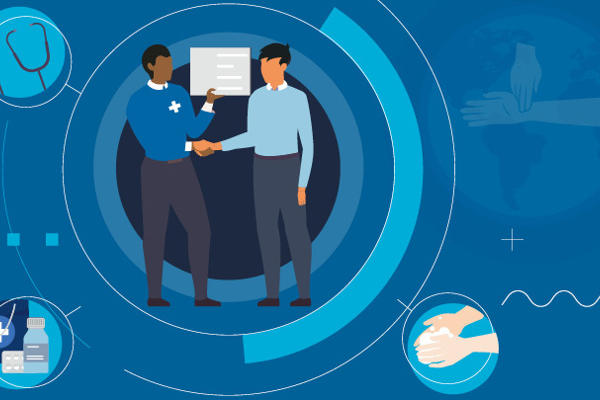Space tourism may finally be about to become a reality. What medical requirements will be involved for those who participate, and can it be made safe? Journalist Radhika Holmström boldly goes to find out.
As one border closes, another one opens. While the current political focus is on extricating the UK from the EU, a parliamentary bill (now in the process of being passed by both houses) aims to enable people to get off the planet altogether.
The Space Industry Bill, introduced by Lord Callanan (parliamentary under-secretary of state for aviation, international and security) is intended to enable ‘commercial spaceflight from UK airports’, with new powers to license a ‘wide range of spaceflight activities’ including ‘rockets and space planes’. According to universities and science minister Jo Johnson, the bill ‘will help make the UK the most attractive place in Europe for commercial launch and enable UK businesses to capture a growing share of this emerging global market’ – a market which is forecast to be worth over £25 billion globally over the next 20 years.
Fly me to the moon
Is space tourism finally about to become a feasible possibility? At the moment, only a small number of very rich people have taken flights to the International Space Station on a Soyuz spacecraft, in joint ventures between private companies and the Russian state. Other private companies – notably Elon Musk’s SpaceX and Richard Branson’s Virgin Galactic – continue to announce that they will be getting off the ground in the next year, again at vast expense.
Whether that will actually happen is still uncertain. ‘The whole space industry is very secretive on the topic at the moment,’ says Dr Daniel Grant, aerospace development director at the Centre for Altitude Space and Extreme Environment Medicine. ‘It has the potential to be a huge money-earner but also for the whole thing to be set back 10 years or so.’ To date, there have been some dramatic and dangerous setbacks, including the death of a pilot in a test flight of Virgin Galactic’s prototype space tourism rocket. But clearly, if this has reached the stage of parliamentary legislation, many people are thinking of it as a serious concern.
Been around the world
In reality, the term ‘space tourism’ covers several different types of flight, some of which are more out of this world than others.
The type that’s likely to become most common – in fact it may become a type of regular ‘commute flight’, as it’ll make it possible to get halfway round the globe in a couple of hours – is ‘suborbital’ flight. These short flights do technically go ‘into space’, as that’s defined by getting 100km above sea level, (the ‘Karman Line’) and passengers get a glimpse of the planet from space and a short period of weightlessness (microgravity, of which more below) – up to a few minutes maximum – before the craft plunges back down towards its terrestrial destination. This is the type of flight that Virgin Galactic expects to provide.
More speculatively, but closer to the idea of a ‘real astronaut’, then there is ‘orbital flight’, taking passengers (using a rocket or another launch vehicle) to the International Space Station (ISS) or to another purpose built facility like a ‘space hotel’. They remain there as they orbit the earth, 250–500 miles from the surface: in reality 93 per cent of the earth’s gravity still operates, but because the ISS is in ‘free fall’, they feel as if they are weightless, experiencing the effects of microgravity. This is the type of flight that a very few people have already undertaken through (extremely expensive) private companies ‘chartering’ a flight on the Russian Soyuz launch rocket. And finally there is ‘deep space’ or interplanetary flight, taking humans further beyond the earth’s atmosphere completely: the proposals to go to the moon, or Mars, or even further out.

Fitness to fly
From a medical perspective, this opens up a whole new – and sometimes rather grey – area. The usual picture of an astronaut is of someone who is, at the very least, pretty fit and in good health. It’s fair to say that not everyone who undertakes a regular flight fits this profile: and indeed that customers who can afford the $250,000 ‘upfront deposit’ required by Virgin Galactic may well include people who have spent their working lives in the boardroom rather than the gym.
So what will the health requirements be for a space tourist? Are there specific risks that can be anticipated and/or mitigated? And what provision is there for someone having a health problem while they’re off-planet?
The main risk of suborbital flight is, unglamorously, motion sickness as the craft swoops up and down. In effect, it’ll be like a giant roller-coaster ride. ‘The main risk is to people with cardiovascular diseases, and there is a possible risk of traumatic organ injury, depending on how you are buffeted about,’ says Dr David Green, lecturer in human and aerospace physiology at King’s College London. ‘But beyond those things, unless there’s a failure with the oxygen supply or the safety system, the thing that worries most potential space flight operators most is the high risk of severe motion sickness because they don’t want people to come back from the first flights saying they were as sick as a dog. It’s not a medical issue as such, because the risk of asphyxiation from it is very low, but it’ll be highly unpleasant and unfortunately it’s very difficult to predict it. It’s actually very common in astronauts. Around 70 per cent have some degree of motion sickness in the first few days.’
Dr Daniela Petrova Quayle, vice-chair of the Royal Aeronautical Society Aerospace Medicine Group Committee, is of the opinion that at the beginning the medical restrictions are likely to be relatively conservative – for instance, they’re likely to exclude people who need additional oxygen, or who use a wheelchair. ‘However, eventual developments are likely to mean that the medical restrictions become much more aligned with current commercial aircraft regulations.’ ‘Every company will probably introduce their own criteria, and there will be differences between the Western criteria and, possibly, the rest of the world, as well as between government organisations and private companies,’ Grant adds. ‘However, there will be exclusion criteria and there is some documentation already. A young tech software billionaire will probably be fine; an overweight diabetic with a heart condition, probably not.’
Virgin Galactic does not have a list of specific disqualifying conditions, but intends to put into place a ‘robust system’ for screening passengers and ensuring they manage any pre-existing conditions. Participants will also get pre-flight training which should (in theory) give them an idea of what that roller-coaster swoop will feel like. ‘We do not plan to have medical personnel on board,’ says flight doctor Dr Tarah Castleberry. ‘There’ll be little time or ability to safely treat a medical condition during the flight. If a medical event does occur, we’ll have a team of medical professionals waiting on the ground.’
Up and away
Orbital flight is less charted territory. However, as early as 2007 the ISS produced ‘joint medical standards and evaluation requirements’ for what it defies as ‘Space Flight Participants… [who are] generally fare-paying passengers without operational responsibilities’. This terminology, Green points out, is important. These passengers do not have a ‘safety-critical’ role in keeping the whole operation running. ‘They’ll go through the basic training but not the training for what to do in an emergency. The 2007 criterion provides guidelines well below those of a proper astronaut: are you fit enough to cover the basic mission, with an extremely low risk of becoming extremely ill?’
At the same time, Green debunks some of the widespread misconceptions about the state that ‘real’ astronauts need to be in. ‘The way astronauts are portrayed in films is the way Apollo astronauts were selected. They were all former fast-jet US pilots, selected on the basis of being highly-functioning individuals who were used to a high amount of risk, talented and highly egotistical.

He adds: ‘The training and requirements for people who work very well as part of a bigger team, and their roles, are now very different: they have expertise in science and technology, in engineering, in geology. It’s a much broader pool of expertise, and much more of an emphasis on the personal and presentational – look at Tim Peake, as opposed to Neil Armstrong. You need to be able to follow and remember procedures, and follow them under situations of extreme stress. But you don’t, in fact, have to be super-fit; it’s more about how low your risk is of having a major medical event.
Today’s astronauts aren’t marathon runners, or super-strong, but they have very low risks of heart disease, or renal stones, or psychiatric events. Essentially they are presented to a medical board by their space agency, with the evidence that they are fit to fly, and the international board evaluates them. That happens every time they have a space mission.’
So even the people with the real, safety-critical roles are not perfect specimens of humanity – though they’re still likely to be quite a lot fitter than some of their passengers. Green’s view is that in reality, if and when orbital space tourism goes ahead, there will be a medical incident at some point, but that this isn’t necessarily a catastrophe. ‘At the moment, if someone has an emergency on the ISS, they can probably be got back to earth in four and a half hours. The only way to do it is in Soyuz – which is the worst ambulance you can think of – but they do get back. Someone in Antarctica for the winter is in a much worse situation.’
‘Deep space flight introduces new tourist potential, with potential to do new things, but it’s unknown territory,’ says Grant. ‘We just don’t know how things will react. How will implanted devices work, for instance?’ Petrova Quayle flags up particular concerns for long-stay flights (such as the proposals to fly a married couple to Mars for a year), including the radiation that people will be exposed to and the effects of prolonged ‘weightlessness’ on their musculoskeletal system. And yet because this is such an unknown, it may actually bring benefits, Grant concludes.
‘Someone might, for instance, feel better in space. There may be a subset of people, say people with joint problems, who never want to come back.
Radhika Holmström is a journalist, writer and editor specialising in health, mental health, race and diversity, and parenting issues. You can follow her on Twitter at @RadhikaHolm.
This article appeared in the October 2017 issue of Commentary.




